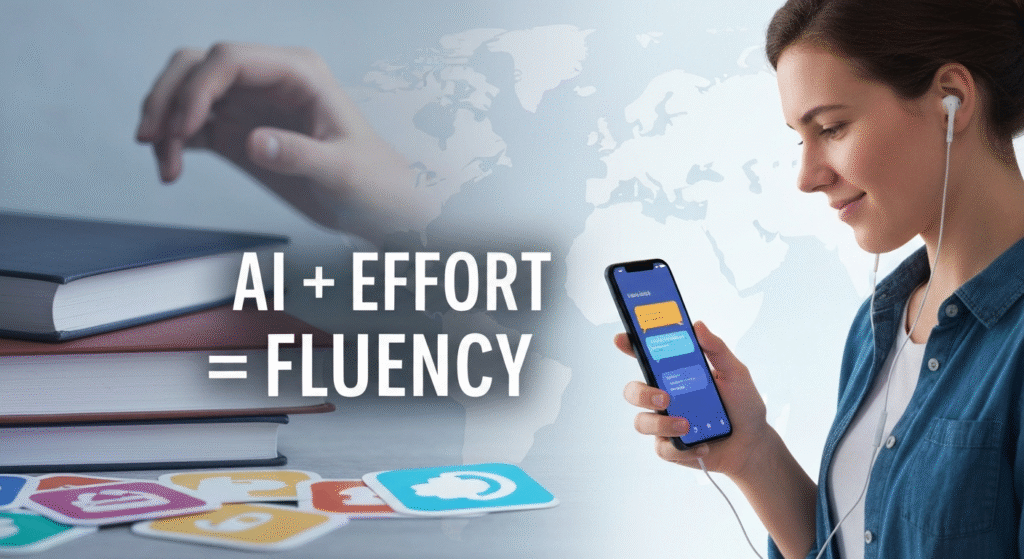Learning a new language often feels like a series of plateaus. You master “hello” and “where is the bathroom,” and then you hit a wall. For weeks, maybe months, you get stuck. You can read the language, but you can’t speak it. You understand the grammar in a textbook, but your brain freezes in a real conversation. This was exactly where I found myself with Spanish. I had the flashcard apps. I had the textbooks. What I didn’t have was a way to practice, fail, and get corrected without judgment, on my own time. Then, I turned to AI, and it changed the game—not by doing the work for me, but by making the work I did 10 times smarter.
My name is John Michael. As someone who has been exploring and writing about AI for years, my curiosity is always piqued by its practical uses. I’m less interested in abstract theories and more in how this technology can solve real, everyday problems. When I hit that frustrating wall with my Spanish, it felt like the perfect test case. I wanted to see if I could apply my understanding of AI to crack this age-old challenge. This article is the result of that experiment, a breakdown of what actually works, what doesn’t, and how you can build a truly effective, AI-assisted learning plan.
The Big Misconception: AI Isn’t a Magic Wand
First, let’s get this out of the way. You will see ads that promise AI can make you fluent in three months while you sleep. That is a lie. Learning a language is not a “content” problem; it is a skill problem. It’s more like learning to play the guitar than memorizing a history book. Your brain has to build new neural pathways. Your mouth has to learn to make new shapes. You cannot shortcut this process.
Here’s the thing: effort is the one thing you can’t outsource. Where AI becomes a superpower is in directing that effort.
Before AI, my study was a mess. I’d spend 20 minutes on a gamified app, get a 50-day streak, but still be unable to order coffee. I’d read a grammar chapter, feel confused, and have no one to ask. My effort was scattered. AI helped me focus that same effort with pinpoint accuracy. It became my 24/7 tutor, my endlessly patient conversation partner, and my personal content generator. It didn’t replace the effort, it multiplied its effect.
My Starting Point: The “Old Way” Frustrations

Like most learners, I started with the most popular apps. My initial journey was a classic tale of high motivation and diminishing returns.
- The Gamified App (Duolingo): I started with Duolingo. It was fun! The green owl was encouraging, the streaks were addictive, and I built a decent base of vocabulary. I learned words for “duck,” “apple,” and “milk.” But after two months, I realized a critical flaw: I was learning to play a game, not speak a language. I could match words in a list, but I couldn’t form a single original sentence. I was trapped in its multiple-choice world.
- The “Serious” App (Babbel): I switched to Babbel, thinking I needed more structure. Babbel was definitely better. It focused on real-life scenarios (“How to introduce yourself,” “Ordering at a restaurant”) and its grammar explanations were clear. I was learning phrases, not just words. But again, I hit a wall. It was all input. I was listening and repeating, but I wasn’t creating. I wasn’t practicing the spontaneous, messy act of real conversation.
My problem was clear: I had zero opportunities to speak and get immediate, gentle correction. A human tutor was expensive and I could only schedule one hour a week. I was afraid of sounding stupid in front of native speakers on language exchange apps. I was stuck.
The Tools I Tested: A Practical Comparison
This is where I started my AI experiment. I broke the tools down into three categories and used myself as the guinea pig.
The All-in-One Apps (The “Guided” Approach)
These are the apps you know, which are now scrambling to integrate AI into their existing platforms.
- Tools: Duolingo (with its new “Max” features) and Babbel (with “Babbel Speak”).
- Pros:
- High Structure: They provide a clear, step-by-step path. You never have to wonder what to study next.
- Gamification: Duolingo’s streaks and leagues are genuinely motivating for daily consistency.
- New AI Features: Duolingo Max offers “Video Call,” an AI conversation with a character. Babbel Speak offers a “judgment-free” AI partner to get you over the fear of speaking.
- Cons:
- The “Walled Garden”: You are limited to their curriculum. You can’t suddenly decide to learn about “space travel” or “gardening” if it’s not in the lesson plan.
- Cost: The best AI features are locked behind their most expensive subscriptions.
- My Experience: I used the free version of Duolingo and the paid version of Babbel. They were excellent for my A1-A2 level (total beginner to advanced beginner). Babbel gave me the sentences, and Duolingo drilled the vocabulary. But I outgrew them. I wanted to talk about my life, my job, my interests. The new AI features are promising, but they are still just a feature of a larger, rigid system.
The General-Purpose Chatbot (The “DIY” Approach)

This was my “aha!” moment. What if I just used the most powerful AI I knew—ChatGPT—as a private tutor? It’s free (or low-cost), and I could control 100% of the conversation.
- Tools: ChatGPT (especially with Voice Mode), Claude.
- Pros:
- Infinite Flexibility: You can talk about anything. You set the topic, the difficulty, and the rules.
- Instant Grammar Explanations: This is its killer feature. You can not only get corrected, but you can also ask why. “Why did you use ‘ser’ instead of ‘estar’ here?”
- No Judgment: It is impossible to embarrass yourself. You can make the same mistake 100 times, and it will correct you 100 times with perfect patience.
- Cons:
- No Structure: It’s the “anti-Duolingo.” It will do nothing unless you prompt it. You must be self-motivated.
- Can Be Unnatural: It’s an AI, not a native speaker. It can sometimes use overly formal language or miss subtle cultural nuances.
- My Experience: This completely broke down my speaking wall. I used my phone’s ChatGPT app in Voice Mode. My go-to prompt was: “Act as my Spanish conversation partner. We are going to have a simple, 10-minute conversation about our day. Please correct any mistakes I make, and after you correct me, briefly explain why it was a mistake in English.”The first time I did this, I was a stuttering mess. But the AI just waited. It understood my broken Spanish and replied simply. When I made a mistake, it would say, “You said ‘Yo soy aburrido,’ which means ‘I am a boring person.’ You probably meant ‘Yo estoy aburrido,’ which means ‘I feel bored.’ We use ‘estar’ for temporary states and emotions.” This was the feedback loop I had been missing.
The Dedicated AI Tutors (The “Integrated” Approach)
After “hacking” ChatGPT, I searched for apps that were built to do this from the ground up. This led me to a new generation of tools.
- Tools: LanguaTalk (Langua), Talkpal, and others.
- Pros:
- Best of Both Worlds: They combine the conversational freedom of ChatGPT with the structure of a learning app.
- Integrated Features: Langua, for example, lets you have an AI conversation (voice or text), and then you can click on any word in the chat to save it to a built-in flashcard deck. This is incredibly efficient.
- More Natural: These tools are fine-tuned for language learning, so their voices and responses often feel more natural than a general-purpose chatbot.
- Cons:
- Newer & Less Known: They don’t have the brand recognition of the giants.
- Subscription: They are subscription-based, but I found the cost was often justified by the combination of features.
- My Experience: This is where I’ve settled now. I use Langua. It formalizes my “ChatGPT hack.” I can have a free-flowing conversation, and it automatically tracks my mistakes and creates a personalized study deck based on my own conversations. It bridges the gap between practice and study perfectly.
Comparing AI Language Learning Tools: A Quick-Look Table
| Tool Type | Examples | Best For… | Pros | Cons | My “Real Results” Takeaway |
| All-in-One Apps | Duolingo, Babbel | Total beginners who need structure and motivation. | Clear path, gamified, builds a solid vocabulary base. | Rigid curriculum, expensive for best AI features, poor for real conversation. | Great for my first 3 months. I learned about Spanish, but I couldn’t speak it. |
| General Chatbots | ChatGPT, Claude | Self-motivated learners (B1+) who need conversation practice. | Infinitely flexible, free/low-cost, amazing for grammar explanations. | Zero structure, can be unnatural, requires you to lead 100% of the time. | This was the key. It cured my fear of speaking and fixed my persistent grammar errors. |
| Dedicated AI Tutors | LanguaTalk, Talkpal | Intermediate learners who want a smart, integrated study system. | Combines conversational freedom with study tools (like flashcards). | Subscription cost, newer platforms. | This is my current tool. It automated my study loop: I talk, I make a mistake, it’s corrected, and it’s saved to my flashcards. |
Real Results: Where I Am Now (and What AI Still Can’t Do)
So, after six months of this AI-assisted approach, what are the real results?
The Wins: What AI Genuinely Improved
- Confidence: This is the biggest one. I am no longer afraid to try. Having failed 1,000 times in private with an AI, failing in public with a native speaker just isn’t scary anymore.
- Grammar Intuition: I finally understand ser vs. estar. I finally get the basics of the subjunctive. Not because I memorized rules, but because an AI corrected me in real-time 50 times while I was trying to express my own thoughts.
- Relevant Vocabulary: My vocabulary is built around my life. I know the Spanish words for “keyboard,” “content,” “article,” and “AI,” because those are the things I talk about. You won’t find those in Chapter 2 of a textbook.
The Limits: Where AI Falls Short
- Cultural Nuance: AI can’t teach you slang. It can’t teach you humor, irony, or the regional differences between Spanish in Spain, Mexico, and Argentina. It can’t tell you when to speak, only what to say.
- The “Human” Element: There is no substitute for the joy of making a native speaker laugh. There’s no AI that can replicate the warmth of a shared joke or the “aha” moment of understanding someone’s culture, not just their words.
- Spontaneous Speed: Real conversations are fast, messy, and overlapping. AI is patient. It waits for you. It’s a fantastic trainer, but it’s not the final match.
My Step-by-Step Method for Integrating AI (Without Overdoing It)
Here is the simple, 4-step-per-day process I developed. It takes about 30-45 minutes and balances structured learning with real practice.
- Foundation (10-15 mins): Use a structured tool. I still use Babbel for this. I do one new lesson to learn the “rule” or “concept” of the day (e.g., a new verb tense). This is the “textbook” part.
- Practice (10-15 mins): Use an AI conversation partner (ChatGPT or Langua). I start with a simple prompt: “Let’s talk for 10 minutes about [topic]. I just learned about the preterite tense, so please try to ask me questions that make me use it.” This immediately puts the “rule” from step 1 into practice.
- Review (5-10 mins): Go over the conversation. I look at the corrections the AI made. If I’m using Langua, I add the new words to my flashcard deck. If I’m using ChatGPT, I copy and paste my 3-5 biggest mistakes into a notebook.
- Immerse (10+ mins): This is the fun part. I ask the AI to “Write me a short, simple news article in Spanish about technology.” Or I’ll find a Spanish-language podcast. This is passive listening, connecting the words I just practiced to the real world.
This “drill, practice, review, immerse” cycle is what built my confidence and skill far faster than any single app could have alone.
Frequently Asked Questions (FAQs)
Can you really learn a language just with AI?
No. You can learn about a language, but to truly learn it, you must interact with real humans and real media (music, movies, books). AI is a powerful supplement, not a replacement. It’s the ultimate training tool to prepare you for the real world.
Which AI language app is the best?
There is no “best.”
- Best for beginners: Duolingo or Babbel.
- Best for intermediate conversation practice (free): ChatGPT (with Voice Mode).
- Best for an all-in-one AI study system: A dedicated app like LanguaTalk.
Is AI good for learning grammar?
It is fantastic. It’s better than a textbook because it’s interactive. You can ask it to explain a concept in five different ways until it “clicks.” You can say, “Give me 10 example sentences of this rule,” and it will.
Will AI make language tutors obsolete?
Not at all. AI is a great tutor, but a human is a coach. A human tutor can understand your personal goals, sense your frustration, and tailor a lesson to your mood. They provide accountability and connection. I use AI to practice 10 hours a week so I can be 10 times more effective in my one hour a week with a human tutor.
Conclusion: Your New Language Partner

AI has not made learning a language effortless. I still have to show up every day. I still get confused. I still make mistakes. The difference is that my effort is no longer wasted. I’m not just spinning my wheels in a gamified app.
Every minute I spend studying is now focused, personal, and effective. The “wall” I hit is gone, replaced by a clear, step-by-step path forward. AI is the patient, 24/7 partner that helps me practice, the expert tutor that explains the “why,” and the personal assistant that generates content just for me. It hasn’t replaced the hard work, but it has made the hard work work.


